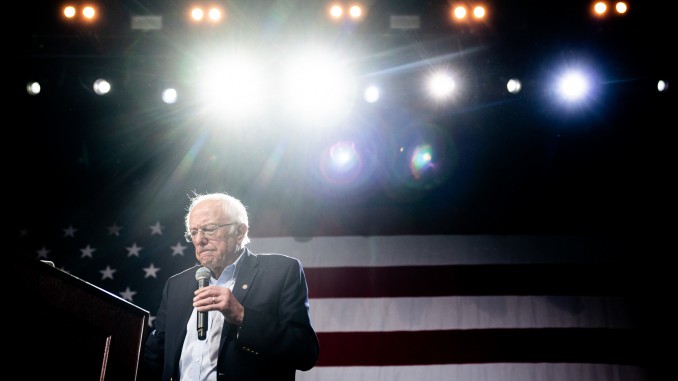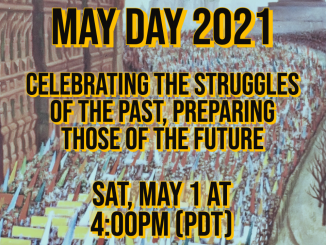
On April 8, Bernie Sanders ended his presidential campaign, but said that the movement around him must continue. Then on April 13, he went “all in” for Joe Biden, endorsing Biden’s candidacy and setting up joint policy committees linking the two campaign staffs. Many who had been activated by Sanders’s campaign, including many young people and others who had never been engaged in politics before, are disappointed. But being discouraged doesn’t provide a political direction. What is the balance sheet of the campaign and what conclusions can we begin to draw?
Sanders was right when he said that we need a movement, but his campaign demonstrated that any movement that is channeled into the Democratic Party will severely limit its possibilities. And the scope of the problems we face – from economic collapse to catastrophic climate change, the rise of authoritarian and xenophobic, racist politics, and more – cannot be seriously addressed in the formal two-year and four-year cycles of electoral politics, let alone the “pass the buck” structures of the existing political system.
What Sanders did that was important
We should acknowledge his intransigence, honesty, and energy, and the impact that his campaign has made. We need to respect Sanders’s willingness to stand against the vast majority of politicians. He didn’t shift his policies to gather votes. His four-year campaign gave validity to the sense that many had that we don’t have to accept watching our lives disintegrate while a small segment of the population gets phenomenally rich.
He shifted the focus of the Democratic Party primary campaign and forced other candidates to address real policy issues in the debates. He reinforced the idea that working people are deserving of a living wage and a decent quality of life. He promoted the idea that health care should be a right. He challenged the idea that the rich and their institutions – Wall Street, Big Pharma, and the like – should control our entire society. He argued that education is a right that should be accessible to all, and that student debt should be abolished. Young people shouldn’t have to enter adulthood burdened by debt that prevents them from exercising their creativity and passions. He acknowledged the fundamental importance of the climate crisis. He challenged the discrimination and racism of this society and championed women’s right to control their bodies.
To reform the Democratic Party or change the system?
The Sanders campaign, and the ideas he stood for, provided many who were new to politics a framework to begin to understand the deep problems of this society, but not their source. His “Not Me, but Us” perspective rang true and is true, but only if our political perspective rejects the Democratic Party and looks beyond elections to the self-organization of working people and oppressed people everywhere.
Sanders’s primary aim was to build a strong left populist wing of the Democratic Party and use it to reform U.S. capitalism. Other progressive activists followed Sanders’s lead and ran for Congress. A few were successful. Alexandria Ocasio-Cortez, Rashida Tlaib, Ayanna Pressley, and Ilhan Omar, all women of color, became stars of the progressive wing of the Democratic Party. Their media visibility has energized those who propose to continue the electoral strategy for change.
Yes, the problem is the control that the big corporations and the rich exert over society. But it isn’t just the influence that “big money” has in the politics of the two-party system. It is the fact that those who control the wealth and productive capacity of society, control the society. The Democratic Party was originally the party of slaveowners and has always represented a section of the ruling class. Today as well, the Democratic Party continues to be the party of a section of the ruling, capitalist class – in the same way the Republicans represent the interests of other sections of that class. The two parties represent different policies for managing society for the bourgeoisie.
The idea that a movement can use the Democratic Party as a vehicle to implement the kind of changes that Sanders advocated was a failed policy to begin with. Sanders maintained that it was possible to change significant aspects of capitalism while leaving the system in place.
The Sanders campaign faced many challenges. It was clear that the Democratic leadership did not want a repeat of the 2016 election, where Sanders posed a real threat to Democratic Party insider Hillary Clinton. In 2019, the party leadership threw open the primary doors to a wide range of candidates, 29 in all. Before the first primary caucuses in Iowa, the debates, polling, and fundraising competitions dropped the number to eleven. Sanders also faced criticism and name-calling in the mass media, particularly during the debates among Democratic candidates leading up to the primary elections. The Washington Post, owned by Amazon’s owner Jeff Bezos, criticized Sanders’s proposal to raise taxes on Amazon. Others mocked him for being a millionaire after his book on the 2016 election sold well. Politico, an inside-the-beltway political journalism company, called Sanders “rich“ and “cheap.“ Others emphasized that clinging to his socialist ideas meant that Sanders was impractical, not being a “team player“ with the rest of the Democratic Party, and un-American. The more Joe Biden, the candidate most favored by the Party machine, faltered in the debates, the more the anti-Sanders media stepped up their attacks.
Sanders’s consistency and early strong polling meant that all the other candidates had to respond to his program to some degree. Elizabeth Warren attracted a significant number of voters with her more moderate defenses of some of Sanders’s ideas. When there was no clear candidate for the Party establishment, Michael Bloomberg, the billionaire former mayor of New York, stepped into the race ready to spend hundreds of millions of dollars on his campaign. The Democratic Party granted special considerations to him, waiving previous conditions for participating in the primary debates. He was allowed to participate in the last two televised debates before all the candidates except Biden and Sanders had withdrawn. The presence of so many candidates divided the vote. When Sanders dropped out of the race, he had 31 percent of the primary votes cast to Biden’s 41.5 percent. Warren had close to 10 percent, as did Bloomberg. Sanders was no longer the insurgent candidate of 2016. He had substantial popular support, reflected in the amount of financial backing that his campaign drew from a large number of individuals giving small donations and the large number of people who attended his rallies. But there wasn’t the same momentum as in 2016. And while the Sanders campaign had a strong appeal to young people, it failed to turn out their vote in the numbers needed to win in the primaries against the Democratic Party machine and traditional base.
Another important factor was that most labor union bureaucracies wanted to stay in bed with the Democratic Party apparatus in both 2016 and 2020. In 2016, seven national unions, representing 1,391,000 workers, had endorsed Sanders, including the American Postal Workers Union, Amalgamated Transit Union, Communication Workers of America, International Longshore and Warehouse Union, National Nurses United, National Union of Healthcare Workers, and United Electrical, Radio and Machine Workers of America. But, compared to 2016, the labor union leadership hedged their bets with so many Democratic candidates running in the early stages of the 2020 primary campaign. In 2020, only four of these – American Postal Workers Union, National Nurses United, National Union of Healthcare Workers, and United Electrical, Radio and Machine Workers of America, representing 401,000 workers – endorsed Sanders. A number of regional, state, and local union organizations also endorsed Sanders in both 2016 and 2020.
Meanwhile, the Democratic Party establishment’s efforts to defeat Trump shifted from the electoral field to the failed attempt to impeach Trump. The distraction of the impeachment proceedings took the focus off the issues that Sanders had been championing. The election was reframed as a question of who had the best chance to beat Trump, instead of candidates’ positions on the issues. The Democratic leadership openly embraced Biden. This became obvious when South Carolina Representative Jim Clyburn endorsed Biden on February 26, four days before the South Carolina primary. Clyburn is the “majority whip“ in the House of Representatives, the highest-ranking African American in Congress, and a leader in the Democratic Party establishment. He said “We know Joe. But most importantly, Joe knows us,” implying that African-Americans who identify as Democrats, especially in the South, could trust Biden more than Sanders.
Biden’s victory in the South Carolina primary launched him back into frontrunner status. With other candidates – notably Amy Klobuchar, Pete Buttigieg, and Kamala Harris – dropping out of the race and casting their support to Biden, and Biden then winning the next round of primaries, Sanders’s likelihood of becoming the Democratic Party’s presidential candidate was greatly diminished. There seemed to be less and less of a possibility of Sanders having enough delegates to make a strong fight in the convention on the content of the party platform. The Democratic Party bosses had strengthened their control. Finally, COVID-19 effectively undercut the Sanders campaign that was so dependent on door-to-door organizing and big public rallies. The campaign was now practically invisible. So the pandemic sealed the deal for Biden, and Sanders dropped out.
What to do
Our main concern is not just to understand the limitations of the Sanders campaign or the pros and cons of electoral strategy for socialists. The COVID-19 pandemic has created a major crisis in the day-to-day lives of ordinary people. It raises immediate questions about the functioning of government and – despite Trump’s daily posturing – moves away from just a narrow focus on the personalities running for president.
This new situation should challenge the perspective of those with a focus on elections as a central pathway to bringing about significant social change. If they give up on fighting for real social change because of this failed Sanders strategy, they will have missed the most important lesson of the campaign. Sanders spoke to people’s hopes, but not to what it would take to turn those hopes into real change. Whether change can be won today doesn’t depend on which candidate wins the election, but on the strength and breadth of the movement that is fighting for change.
A movement powerful enough – to not just get Sanders elected, but actually implement the program he championed – would be powerful enough to contest for control over society. So why would we settle for anything less? It is possible, although very unlikely, that a Sanders presidency could have led to some forms of a national health program, student debt relief, and perhaps other reforms addressing the climate crisis. But challenging the domination and profits of the insurance and pharmaceutical industries as well as defeating the power of the big oil companies, could only occur through a mass mobilization on a scale that this country has never seen before. And such a mobilization could launch a movement, a revolutionary movement, to eliminate the source of all the problems – capitalism itself. Elections appeal to people as they are – often scared, pragmatic, isolated, and with old assumptions and ideas. A movement changes minds collectively as people go through an experience together, see their collective strength and power, and learn to rely on themselves.
It is certainly understandable that people would want to vote for Biden in order to get rid of Trump. But it would be tragic if those inspired by Sanders limit their hopes and our prospects to simply defeating Trump and settling for placing their hopes in Biden. Yes, the COVID-19 pandemic has undoubtedly shown Trump’s total incompetence, narcissism, and contempt for the lives of ordinary people. But it certainly wasn’t a simple question of Trump’s venality and shortcomings. The pandemic has also revealed that the overall functioning of this capitalist system at all governmental levels is unwilling and unable to address the real problems that the majority of people confront. If we recognize capitalism’s responsibility for this pandemic, as well as for the climate catastrophe and the full range of chronic social and economic horrors that we face – could it be any clearer that we need total systemic change?
The challenges that we confront today are enormous. Even before the COVID-19 pandemic, the amount of debt in the world was enormous and growing. The inevitability of a severe economic crisis coupled with the threat of major climate catastrophes rules out placing hopes in or focusing on elections as the means to social transformation.
Scientists are constantly warning us that we probably have less than 10 years to radically change our economic behavior. And this necessitates fundamental changes in the economic, political and social organization of society. It is unsustainable and deadly to continue to run a system based on profit at the expense of our lives and the health of the planet. The Earth is our home. There is no Planet B. We don’t have the time for electoral hope and detours and other half measures. We have to mobilize our forces to address the real challenges we face and address them quickly.
Socialists, and all those who want to fundamentally change the society, must direct all of our energies into organizing movements against exploitation and oppression, and responding to the existential climate crisis. We need to engage with the working class as our top priority. We can’t sit around and wait for a social movement to begin that work. We need to work with other popular movements against all forms of oppression, and we have to build revolutionary organizations on an international scale that can lead the struggle to overthrow capitalism and build a new socialist world.
featured image credit: Erin Schaff/The New York Times




